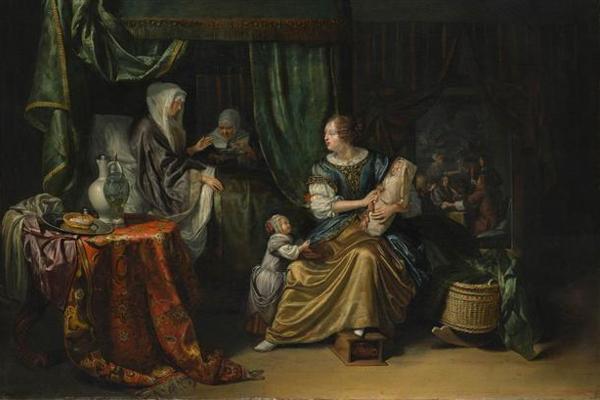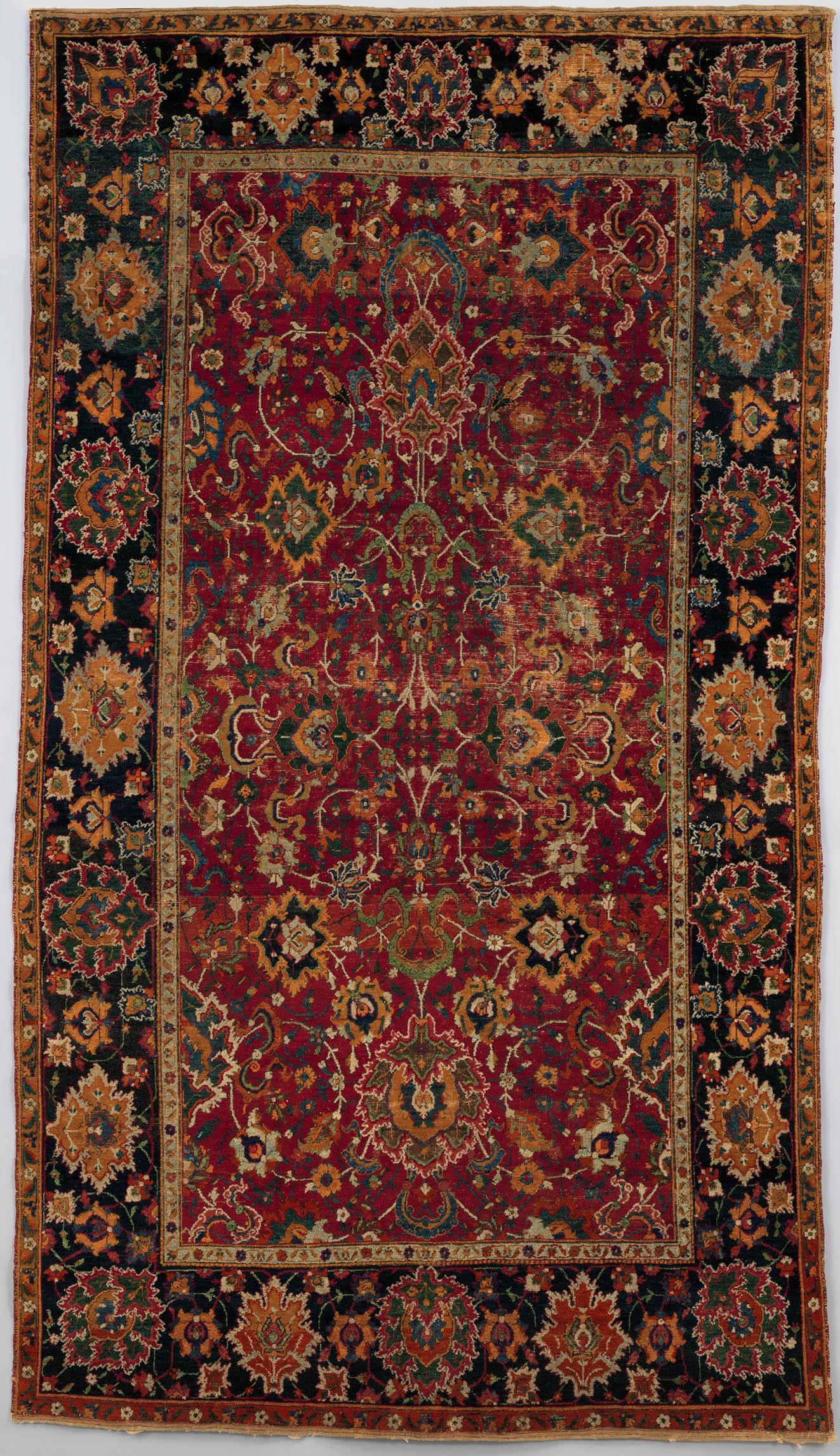Depicting MidEast carpets in Renaissance paintings
Niki GAMM


Matthijs Naiveu’s Newborn Baby (1675).
Pile carpets were being made with geometric designs in Anatolia as early as the 13th century and probably before. This was a time when the Seljuks of Rum were the masters of Anatolia and had even begun trading with Venice (1220). In particular, the carpets being produced at Konya, the capital of the Rum Seljuks, were lauded by the renowned traveler Marco Polo as the best in the world.In the next century, paintings in Europe began to show images of carpets that came from Anatolia and Iran. Because these imported carpets were so expensive, they were mostly to be found in Catholic churches and kingly palaces. In fact, these textiles were at first seen in religious scenes. For example, the depiction of St. Louis of Toulouse (1274-1297) shows the saint as a bishop holding out a crown to Robert of Anjou, an event that happened in 1295, but was not painted until 1317, when Louis was canonized. Underneath the bishop’s throne is a carpet from Anatolia. Carpets at this time were also produced in Spain by the Moors and one was depicted in a fresco from the 1340s in Avignon, France.
Following the expansion of the Ottoman Empire into the Balkan area and the expansion of trade between it and other European countries, carpets appeared more and more frequently in portraits. For example, Fatih Sultan Mehmed II sent King Ferdinand of Naples 100 carpets in 1464 according to Nurhan Atasoy and Lale Uluç in their book, “Impressions of Ottoman Culture in Europe: 1453-1699. Diplomatic gifts such as these ranked high and it was not just the Ottoman rulers who were sending carpets as gifts.


Genoa and Venice sent the Habsburg rulers carpets in the 16th century. Documents support the pictorial record in the form of inventories from palaces, churches and houses. The paintings show that these carpets were not used as floor coverings but as decorations hanging on walls or covering furniture. They might also be used in religious scenes in which the Virgin Mary was depicted, as mentioned above, under the thrones of important ecclesiastical figures or displayed on ceremonial occasions. In other words, the carpets shown in paintings and frescoes in the 15th and 16th centuries were owned by people or institutions of high social and economic status.
Carpets of the East in Paintings from the West
From the 17th century onwards, Ottoman and Persian carpets were no longer the exclusive property of the very wealthy and the well-connected. Rising wealth amid the middle class allowed for significant numbers of purchases. One also sees these carpets in the homes of the wealthy, draped on tables. Various countries such as Spain, Portugal, France and the Netherlands were able to produce their own carpets using the patterns of Turkish carpets that had become popular and still called “Turkish” carpets.
The exhibition “Carpets of the East in Paintings from the West,” which opened March 11 at The Metropolitan Museum of Art in New York, shows three mid-17th-century Dutch paintings along with three actual rugs of the same period, corresponding to the rugs in the paintings. The three paintings on view—all of which are from the Museum’s European Paintings Department—are Gabriël Metsu’s “A Musical Party” (1659); Cornelis Bisschop’s “A Young Woman and a Cavalier” (early 1660s); and Matthijs Naiveu’s “Newborn Baby” (1675). The related carpets on display are from the holdings of the Department of Islamic Art. They are of the “Lotto,” Indo-Isfahan, and “chessboard” types.


Bold, stylized vegetal arabesques in yellow on a red ground characterize “Lotto” carpets, which are named after a famous altarpiece by Italian Renaissance painter Lorenzo Lotto (c.1480 - c. 1557) that depicts a similar carpet. Early examples of Lotto carpets exhibit borders, thought to derive from a rectilinear form of Arabic script known as “kufic,” this type of interlaced border is characteristic of many early Turkish carpets. The painting by Bisschop, “A Young Woman and a Cavalier,” shows the Lotto type carpet.
The Lotto carpets were previously known as Small-pattern Holbein Type II although Hans Holbein the Younger never painted one, unlike Lotto did so several times, though he was not the first artist to show them. Though they look very different from Holbein Type I carpets, they are a developments of the type, where the edges of the motifs are in yellow on a red ground with arabesques suggestive of foliage and end in branched palmettes.
Indo-Isfahan carpets range from small to extremely large floor coverings. These densely knotted textiles feature a very rich and nuanced color palette and were handmade in India, primarily in the 17th century, imitating Herat (Afghanistan) designs. Many were exported to Europe, especially to Portugal and Holland, by East India companies and are frequently seen in 17th-century Dutch paintings as illustrated by the one on display at The Met (Naiveu’s “Newborn Baby”).
The usual field design consists of elaborate vine-leaf and floral palmettes in pairs, pointing in opposite directions and connected by scrolling vines, together with curving, feathery lancet leaves, cloud bands, and a host of small floral motifs. Stylized peonies and lotuses alternate in the border.
Chessboard carpets
“Chessboard” carpets are so named because of the grid-like arrangement of the motifs. In the case of the one on display at The Met (Metsu’s “A Musical Party”), geometrical stars make up the grid. They are often called Mamluk or later, Damascus rugs, because they were produced in Damascus in the 16th and 17th centuries. Mamluk rugs have complex designs with large medallions containing intersecting compartments based on geometric forms. The borders are made up of oblong medallions or cartouches.
Aside from the designs, they are made of finely woven, lustrous wool. It is easy to see the continuation of the Mamluk carpet in the Damascus rug of the 16th and 17th centuries.
Among the other field patterns that occur is a large one with several medallions. Damascus was a major center in Mamluk Syria and when the Ottomans conquered and annexed the Mamluk territories in 1517, Mamluk carpet production continued. It is known that the Ottoman court commissioned carpets from the Cairo workshops and these had a florid arabesque style.
The exhibition at The Metropolitan Museum of Art, which has been made possible by The Hagop Kevorkian Fund, continues until June 29, 2014.
